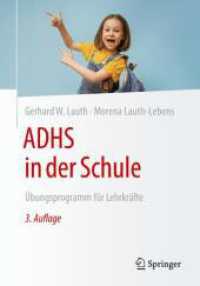Full Description
More than 40 years after the official recognition of infantile autism in DSM-III, advances continue to be made in our understanding of the possible causes, assessment and evaluation, and treatment of autism spectrum disorder (ASD). With contributions by dozens of experts in the field, this second edition of the Textbook of Autism Spectrum Disorders has been updated to reflect the latest research in ASD.
Unrivaled in its thoroughness, this volume discusses issues of assessment and evaluation; examines the etiology of ASD and its recognized associations with other medical conditions; analyzes standard and experimental treatments; and delves into social policy issues pertinent to individuals with ASD and those who treat them.
With summary points in each chapter and copious lists of recommended readings, this is an indispensable resource for psychiatrists, psychologists, neurologists, social workers, speech therapists, educators, and all others in the continuum of care.
Contents
Part IA
Chapter 1. Epidemiology of Autism Spectrum Disorders
Chapter 2. TBD
Chapter 3. Pediatric and Neurological Assessments
Chapter 4. Gender Dysphoria, Gender Incongruence, and Sexual Identity
Chapter 5. Racial and Ethnic Disparities in Assessment and Evaluation of Autism Spectrum Disorder
Chapter 6. Digital Biomarkers in Diagnostics and Monitoring of Autism Spectrum Disorders
Part IB
Chapter 7. Social Communication
Chapter 8. Restricted and Repetitive Behaviors
Chapter 9. Diet and Nutrition
Part IIA
Chapter 10. Genetics and Genomics of Autism
Chapter 11. Epigenomics
Chapter 12. Prenatal, Perinatal, and Parental Risk Factors
Chapter 13. Animal Models of Autism Spectrum Disorders
Chapter 14. Electrophysiological Studies Across ASDs
Chapter 15. Environmental Toxicity and Immune Dysregulation
Part IIB
Chapter 16. Overview of Syndromic Causes of Autism and Commonalities in Neurobiological Pathways
Chapter 17. Fragile X Syndrome and Associated Disorders
Chapter 18. Tuberous Sclerosis Complex
Chapter 19. 16p11.2 and Other Recurrent Copy Number Variants Associated With Autism Susceptibility
Chapter 20. Rett Syndrome
Chapter 21. Prader-Willi Syndrome
Part IIC
Chapter 22. Neuroanatomical Findings in Autism Spectrum Disorders
Chapter 23. The Amygdala in Autism Spectrum Disorders
Chapter 24. Neurobiology of ASD Informed by Structural Imaging Research
Chapter 25. Positron Emission Tomography
Chapter 26. Functional Magnetic Resonance Imaging
Part IIIA
Chapter 27. Serotonergic Medication in Autism Spectrum Disorder (ASD)
Chapter 28. Antipsychotics
Chapter 29. Treating Hyperactivity in Children With Pervasive Developmental Disorders
Part IIIB
Chapter 30. Complementary and Integrative Approaches
Chapter 31. Experimental Therapeutics: Oxytocin
Chapter 32. Vasopressin
Chapter 33. N-Acetylcysteine
Chapter 34. Arbaclofen: From Animal Models to Clinical Trials in Autism
Chapter 35. Cannabis, Cannabinoids, and Immunomodulatory Agents
Part IIIC
Chapter 36. Behavioral Treatments for Autism Spectrum Disorder
Chapter 37. Early Start Denver Model
Chapter 38. The Developmental, Individual Difference, Relationship-Based Intervention Model: A Comprehensive Parent-Mediated Approach
Chapter 39. Autism Interventions in Schools Mediated by Teachers, Paraprofessionals, and Peers
Chapter 40. Language and Communication Challenges and Treatments in Autism Spectrum Disorder
Part IIID
Chapter 41. Transcranial Magnetic Stimulation
Chapter 42. Stem Cell and Gene Therapy for Autism Spectrum Disorders
Chapter 43. Gene Therapy and Molecular Interventions
Part IV
Chapter 44. Consortiums
Chapter 45. Employment and Life Outcomes
Chapter 46. Autism Strengths and Neurodiversity
Chapter 47. Role of Patient Advocacy Groups in Treatment Development






